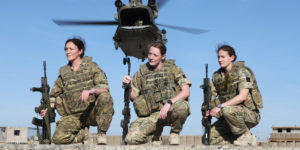
Female veterans feel less supported than their male counterparts after their military service, research from SSAFA, the Armed Forces charity has revealed.
The YouGov survey (1) which was issued as part of the charity’s report The Nation’s Duty found that almost half (46%) of female veterans in the UK felt that the support for male veterans is better than for female veterans. Almost as many (43%) reported feeling on their own with no one looking out for them after they hung up their uniform.
This research is reflected in the increased number of women coming forward asking to be matched with an SSAFA mentor. Currently, female mentees makeup 22% of people requesting the service, which is disproportionate to the male and female (90%/10%), split of the Armed Forces. (2)
The SSAFA mentoring service provides one-to-one support for service leavers and their families during the pivotal transition back to civilian life. SSAFA mentors help with practical and emotional support, assisting with decision making, supporting career decisions and offering independent and confidential advice.
When questioned about their experiences, over a third of former servicewomen (35%) said they weren’t fully prepared for civilian life. Further to this, 38% of female veterans said they did not plan their post-military career before they left the Armed Forces. Although many service leavers thrive in civilian life, if a veteran is struggling and the issues are not addressed early enough, they can escalate to a stage where more drastic intervention may be necessary.
These veterans may later re-emerge needing the charity’s support. SSAFA mentoring service looks to address whether this could be avoided by providing early preventative support.
Gary Williams, Head of SSAFA’s Mentoring Service, said:
“Whilst it’s concerning that female veterans don’t feel they are getting the right support, it is reassuring that we continue to see a rise in former servicewomen approaching SSAFA to be paired with a mentor.
“Currently, female serving personnel make up just under 10% of the Armed Forces, but with close combat roles being opened to women recruits, it’s possible we will see a further increase in the demand for our service.
“All servicewomen, female veterans and female spouses are eligible for our support services including SSAFA mentoring and we would encourage anyone facing difficult times to get in touch.”
(1) YouGov survey was based on the responses of a panel of 251 veterans, aged 18-45, answering an online questionnaire.
(2) Female serving personnel currently make up 10% of the Armed Forces.
TMT Comment:
The raw statistics would appear to provide a rather gloomy view of the support available to women, but they warrant a much closer examination of the facts to see where and how the perception has grown amongst female Veterans that they are less cared-for than men. From the outset, it has to be emphasised that this is to do with the support provided generally after leaving, and not specifically about problems such as front-line PTSD, which one might assume would currently apply less to most women in the forces than men, though an obvious exception might be amongst those who served with medical units in the Gulf or Afghanistan, for example.
The next question would be where the failures occur. Is it within the Armed Forces in the period prior to leaving, or is it with the support received after leaving and while out in Civvy Street looking for jobs, housing and other support. If the former, then it points to a clear problem within the military system; if the latter it might be more problematic to solve.
Thirdly, it has to be asked what sort of support is felt to be missing. It might be that the support is there - but it is not the “right” support. In which case, it has to be asked whether actual needs differ between men and women, or whether perceptions of what is on offer differ sufficiently to have to re-package, rather than re-organise, what is being made available. For example, are resettlement courses aimed predominantly at male occupations in Civvy Street, or are those intended for women not properly advertised?
The whole question of why women should feel less supported is concerning because, by relying upon organisations such as SSAFA, the “buck” has been effectively passed by the MOD to charitable organisations - which is wrong by any reckoning. If there is a systemic problem, then the system has to be modified to deal with it on a systematic basis - and by the MOD.
There is another issue here, which is that there is a tendency in this modern world to try to pretend that men and women are all the same. We are not, and this is a good example of how a system that is intended to deal with “a Veteran” is actually not completely fit for purpose and that someone in the MOD has to ask why such a high proportion of women leaving the Armed Forces should feel so let down. Perhaps a study is underway - in which case it would be very interesting to hear from anyone who has been interviewed about this matter.
We hope to bring a follow-up to this piece. In the meantime, please do get in touch if you have any thoughts or opinions on this topic.
Words: SSAFA press-release and TMT comment
Image via National Army Museum

Comments on Female veterans feel less supported on Civvy Street than their male equivalents